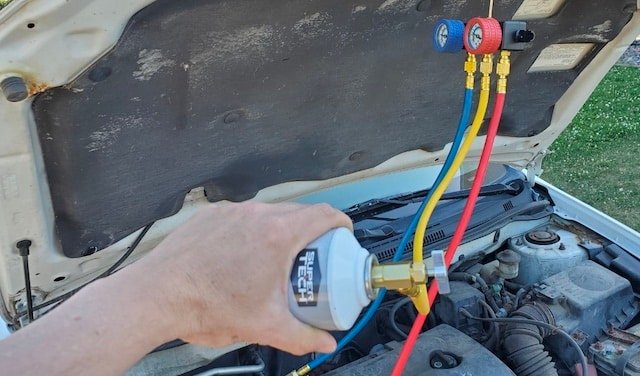One of the most annoying vehicle problems is a faulty air conditioner. During the warmest months, you won’t want to end up with a car that won’t cool you on command. Luckily, AC problems are quite easy to diagnose and fix so you won’t have to consider taking a trip to the shop.
You won’t require much technical knowledge to check for the problem with your Toyota Highlander AC but when it comes to repairing or replacing parts, you would need a bit of technical knowledge at the least.

Most people with AC problems would jump right into charging the system with refrigerant to see if it fixes the problem, but that’s not just how to go about it. While low levels of refrigerant is a common AC problem, you might actually be dealing with a leakage which could be from the evaporator or hoses. So before you spend extra on refrigerant, you would make to make sure you check at the parts for leaks.
Right after that, you can jump straight into these causes and fixes for Toyota Highlander AC Not Working.
Toyota Highlander AC Not Working: Common Causes
There are just a few causes of AC problems that could be troubling your AC system. You should check each part listed for any signs of damage or problems and have it fixed.
Blown Fuse – Like other electrically-controlled systems in the car, the AC system comes with its own corresponding fuses that will blow to prevent the system from getting damaged due to over-current.
Faulty Blower – If you notice that there is no air coming out of the vents, it is likely that the blower fan is faulty or that the fuse linked to the blower fan is blown.
Insufficient Pressure – The AC system requires a certain amount of pressure to operate. If there is too little or too much pressure, then the AC system won’t function properly. Sometimes pressure problems in AC systems are due to leaks.
Compressor Problems – the compressor could fail and in such cases, it would have to be replaced. You will also have to check other parts of the compressor including compressor clutch and compressor shaft seal for damages and leaks as they would pose a problem.
Toyota Highlander AC Not Working: Fixes
Check the AC Fuses
If the AC system refuses to come on or is not working, then you should head to the fuse box and check for any blown fuses. You should find the fuse box to the left of the instrument panel just behind a small storage compartment.
Pop the storage compartment out to give you access to the fuse box. You should find some instructions or info that will help you locate the fuse box linked to the AC system.
If you notice any blown fuses, replace them with new ones of the same amperage rating
You should also check the inside dashboard for any loose connection or wires. Repair any broken connection or replace if necessary. Another thing to check is the temperature control unit. This might cause the AC system to malfunction if faulty.
To confirm that the temperature control unit or thermostat is faulty, you would have to check if it responds to any settings. If it doesn’t, then it would have to be replaced.
Check the AC Controls
Getting your AC fixed would be as simple as replacing the AC controls. Inspect the controls for any damage. You should also check if they are loose or hard to move. If so, then they would have to be replaced.
Check the Blower Fan
Without the blower fan, you won’t get any cold air flowing into the cabin. This doesn’t mean there is a fault with the AC but rather, you would have to check and fix the blower fan. Blower fan issues are not actually straight forward. You won’t always have to replace the blower fan motor to get things to work.
In some cases, the faulty blower fan could be due to a blown fuse. Once again, you would have to check the fuse box for the blower fan’s fuse. Check if the metal strip inside the fuse is broken. This means the fuse is blown and would have to be replaced.
If the fuse looks fine, then you should inspect the blower fan. The blower fan motor might have failed and would have to be replaced.
Inspect the Compressor
There are several compressor problems that could prevent the AC from functioning fully. You could be dealing with a faulty compressor, a defective compressor clutch, a worn-out compressor belt, or a leak around the compressor shaft seal.
To isolate the cause, you would have to inspect the compressor.
Check under the hood to see if the AC compressor clutch engages. If the system if functioning properly, then you will see and also, hear the clutch turn over. If this doesn’t happen, then the system could be low on refrigerant.
Before refilling the system with refrigerant, check if the clutch is receiving voltage. If it is but still not engaging the compressor, then it could be defective. Understanding the difference might be complicated for some car owners so if you have to check the compressor clutch, it might be best taking the car to the shop.
The clutch would have to be replaced if it is defective.
Another thing to note is a leak. Check for leaks around the compressor shaft seal. If you notice any, then you would have to replace the seal.
There are also chances that the compressor would be faulty. If such is the case, then you would have to replace the compressor.
Overall, compressor problems are best left to your mechanic. They should be able to isolate the actual cause and tell you how to go about it.
Final Thoughts
Before going ahead with any fix, you should inspect the system entirely. Sometimes AC problems could be a combination of several faulty components. You can start by checking all fuses corresponding to the AC system, heater system, and blower fan.







